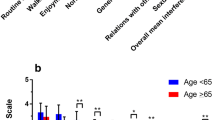Abstract
Background
Neurotoxicity is a common side-effect of cancer treatment, but no scales have been validated for the pediatric population. The objective of this study was to test the reliability and validity of the pediatric modified-Total Neuropathy Scale (ped-mTNS) to measure chemotherapy-induced peripheral neuropathy in school-aged children.
Methods
Forty-one subjects aged 5–18 years undergoing chemotherapy with vincristine or cisplatin and 41 age- and gender-matched controls completed study measures. Subjects were tested with the ped-mTNS at a specified time during treatment. Standardized measures of balance and hand function were completed concurrently. Internal consistency of the ped-mTNS was evaluated using Chronbach’s alpha. Validity was tested by comparing case and control ped-mTNS scores as well as testing the hypothesis that ped-mTNS scores would be associated with scores on tests of balance and manual dexterity. Inter-rater and test–retest reliability were each assessed in a subset of 10 subjects.
Results
Twenty-three subjects with acute lymphoblastic leukemia, six with lymphoma, and 12 with solid tumors completed measures along with 41 age- and gender-matched controls. Internal consistency was acceptable with a Chronbach’s alpha of 0.76. Children undergoing treatment for cancer had significantly worse scores on the ped-mTNS compared to controls (subjects, 8.7 ± 4.2; controls, 1.4 ± 0.9; p < 0.001). As hypothesized, scores on the ped-mTNS were associated with measures of balance and manual dexterity. Inter-rater and test–retest reliability was acceptable (intraclass correlation coefficients >0.9 each).
Conclusions
The ped-mTNS is a reliable and valid measure of chemotherapy-induced peripheral neuropathy in school-aged children that is associated with relevant functional limitations.

Similar content being viewed by others
References
Ries LAG, Smith MA, Gurney JG, et al. (eds) (1999) Cancer incidence and survival among children and adolescents: United States SEER Program 1975–1995, National Cancer Institute, SEER Program. NIH Pub. No. 99–4649. Bethesda, MD
Markman M (2006) Chemotherapy-induced peripheral neuropathy: underreported and underappreciated. Curr Pain Headache Rep 10:275–278
Cornblath DR, Chaudhry V, Carter MS et al (1999) Total Neuropathy Scale: validation and reliability study. Neurology 53:1660–1664
Cavaletti G, Bogliun G, Marzorati L et al (2003) Grading of chemotherapy-induced peripheral neurotoxicity using the Total Neuropathy Scale. Neurology 61:1297–1300
Cavaletti G, Jann S, Pace A et al (2006) Multi-center assessment of the Total Neuropathy Scale for chemotherapy-induced peripheral neurotoxicity. J Periph Nerv Syst 11:135–141
Wampler MA, Miaskowski C, Hamel K et al (2006) The modified total neuropathy score: a clinically feasible and valid measure of taxane-induced peripheral neuropathy in women with breast cancer. J Support Oncol 4:9–16
Wright MJ, Galea V, Barr RD (2005) Proficiency of balance in children and youth who have had acute lymphoblastic leukemia. Phys Ther 85:782–790
Hartman A, van den Bos C, Stijnen T, Pieters R (2009) Decrease in motor performance in children with cancer is independent of the cumulative dose of vincristine. Cancer 106:1395–1401
Gilchrist LS, Tanner L, Hooke MC (2009) Measuring chemotherapy-induced peripheral neuropathy in children: development of the Ped-mTNS and pilot study results. Rehabil Oncol 27:7–15
Bruininks RH, Bruininks BD (2005) BOT-2: Bruininks–Oseretsky test of motor proficiency, 2nd edn. Pearson Assessments, Minneapolis
Bell JA (1984) Semmes–Weinstein monofilament testing for determining cutaneous light touch/deep pressure sensation. Star 44:8–11
Hilz MJ, Axelrod FB, Hermann K, Haertl U et al (1998) Normative values of vibratory perception in 530 children, juveniles, and adults aged 3–79 years. J Neurolog Sci 159:219–225
Coutinho dos Santos LH, Bruck I, Antoniuk SA, Sandrini R (2002) Evaluation of sensorimotor polyneuropathy in children and adolescents with type I diabetes: association with microalbuminuria and retinopathy. Pediatric Diabetes 3:101–108
Medical Research Council of the United Kingdom (1978) Aids to examination of the peripheral nervous system: memorandum no 45. Pedragon House, Palo Alto
Dick JPR (2003) The deep tendon and the abdominal reflexes. J Neurol Neurosurg Psychaitry 74:150–153
Dietz JC, Kartin D, Kopp K (2007) Review of the Bruininks–Oseretsky test of motor proficiency, second edition (BOT-2). Phys Occup Ther Pediatr 27:87–102
Streiner DL, Norman GR (2008) Health measurement scales: a practical guide to their development and use, 4th edn. Oxford University Press, New York
DCTD, NCI, NIH, DHHS (2010) Cancer Therapy evaluation program, common terminology criteria for adverse events, Version 4.03. http://evs.nci.nih.gov/ftp1/CTCAE/CTCAE_4.03_2010-06-14_QuickReference_5x7.pdf. Published June 14, 2010. Accessed 23 January 2011
Postma TJ, Heimans JJ, Muller MJ et al (1998) Pitfalls in grading severity of chemotherapy-induced peripheral neuropathy. Ann Oncol 9:739–744
Lavoie Smith E, Cohen JA, Pett MA, Beck SL (2010) The reliability and validity of a modified total neuropathy score-reduced and neuropathic pain severity items when used to measure chemotherapy-induced peripheral neuropathy in patients receiving taxanes and platinums. Cancer Nurs 33:173–183
Ramchandren S, Leonard M, Mody RJ et al (2009) Peripheral neuropathy in survivors of childhood acute lymphoblastic leukemia. J Periph Nerv Syst 14:184–189
DeVellis RF (2003) Scale development: theory and application, 2nd edn. SAGE, Thousand Oaks
Acknowledgments
The following individuals were instrumental in the success of this research: MC Hooke RN, PhD; A. Logelin, CRA; K. Ites, PT; and K. Ness PT, PhD. In addition, we would like to thank the patients, families, physicians, and nurses of the hematology/oncology clinic at Children’s Hospitals and Clinics of Minnesota.
Funding source
Pine Tree Foundation, St. Paul MN
Disclosure statement
The authors declare the absence of any conflicts of interest in this publication.
Author information
Authors and Affiliations
Corresponding author
Appendix A
Appendix A
Pediatric-modified total neuropathy scale


Rights and permissions
About this article
Cite this article
Gilchrist, L.S., Tanner, L. The pediatric-modified total neuropathy score: a reliable and valid measure of chemotherapy-induced peripheral neuropathy in children with non-CNS cancers. Support Care Cancer 21, 847–856 (2013). https://doi.org/10.1007/s00520-012-1591-8
Received:
Accepted:
Published:
Issue Date:
DOI: https://doi.org/10.1007/s00520-012-1591-8




